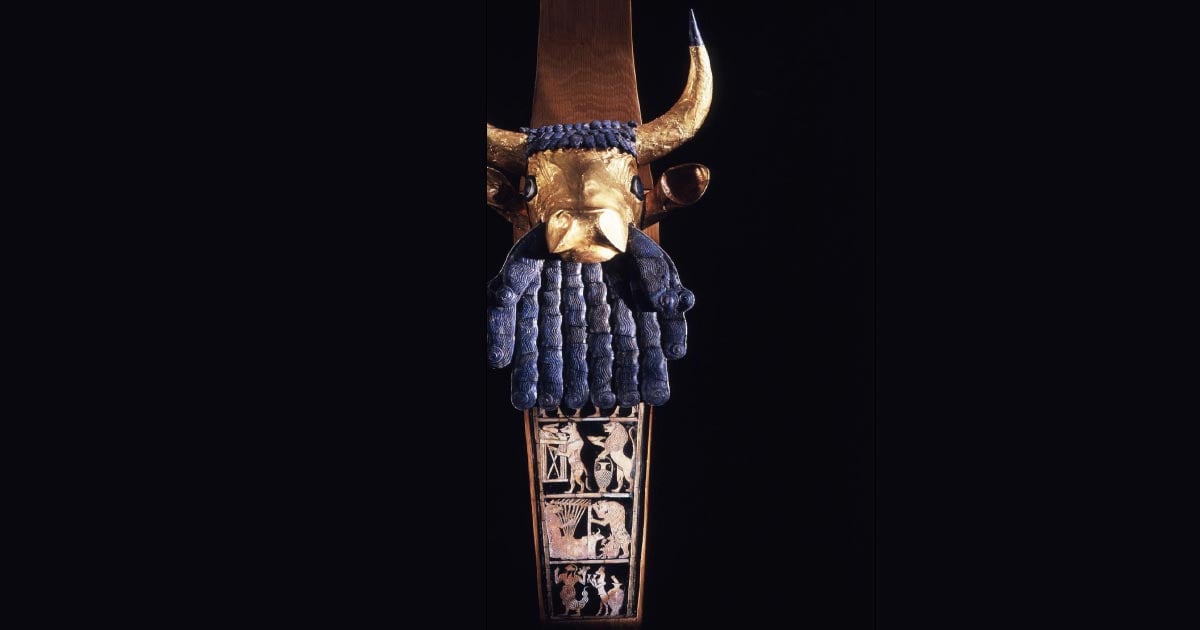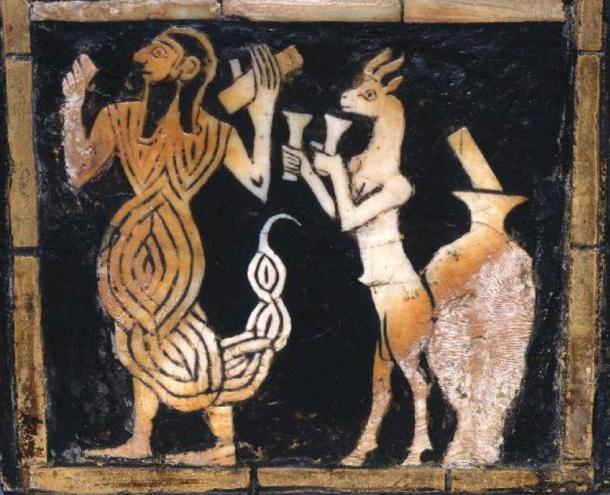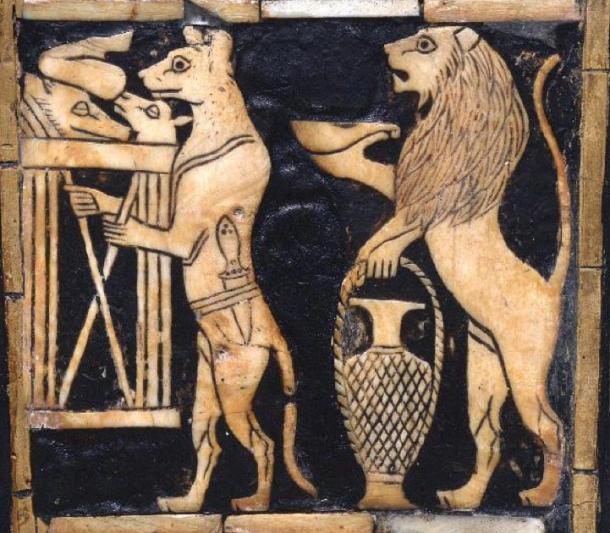Satire in Mesopotamia: Unravelling the Bull Headed Lyre of Ur
 |
| Left: Front angle of the reconstructed Bull Headed Lyre found in the Sumerian Royal Tombs of Ur in Mesopotamia, c. 2500 BC. Source: Penn Museum |

Full shot of the Bull Headed Lyre found in the Sumerian Royal Tombs of Ur, being painted at the Penn Museum. ( Penn Museum )
The Bull Headed Lyre was found in the Sumerian Royal tombs of Ur, Mesopotamia, in the 1920s. It is possible that the images depicted belong to stories and fairy tales that were well known to the Mesopotamians/Sumerians. If this was the case, the stories themselves must have been hilarious.
All the characters except for two are animals acting like humans. The exceptions are the mixed human-scorpion character in the bottom image, which to my mind shows that all figures are symbolic, and the male person in the top image who is human, but his visage is put on the two bulls. Depending on the level of animal form, the images represent types of personalities of different people rather than a specific person. Interestingly, these personalities are types that we still recognize today.

All the front images from the Bull Headed Lyre found in the Royal Tombs of Ur. ( Penn Museum )
In general, understanding cuneiform writing demands skill, however, understanding these images is simpler. It only takes some focus on the details and common sense.
Greed
By looking at the scorpion man in the bottom image, we can see that he is holding something, perhaps a clay cuneiform tablet in his left hand. Another one of these ‘tablets’ sticks out of a big jar. Presumably, he must be the owner of whatever it is. It looks like he has just emptied a chalice, celebrating another victory, and surely very satisfied with himself, saying: “AH! I’m the best!”

Bottom image on the Bull Headed Lyre. ( Penn Museum )
The scorpion tail reveals that his nature is to destroy others for his own benefit, and this is why he owns so much. This is a rich man, who has not been characterized flatteringly. Nor is his servant, the goat, who is so focused on pleasing his master that he holds not just one but two chalices ready for him. The goat looks so servile and smarmy, that it is easy to lose respect for him.
Furthermore, in Mesopotamian art the goat figure is often seen depicted standing on its hind legs, with the front legs up a stem of a bush in more noble scenes. But in this depiction, he has lost that dignity. We are led to feel contempt for this rich man’s servant.
Treasures From The Royal Tombs of Ur - Revised 1999, Penn Museum
When I read “The Great Fatted Bull, a Sumerian murder mystery” translated by Jerald Jack Starr (reference below), I was thrilled to find that this exact type of bad master is described in detail.
Entertainers
The next image is excellent. Here we can see entertainers and musicians. A lyre, similar to the one that the decoration sits on, is played by a donkey. The connotations of donkey immediately lead us to thoughts of vaunting and stubbornness, or stupidity. There is also a dancing bear, not exactly as elegant as a real dancer, and a small dog or something similar, shaking his sistrum rattle to the rhythm, nervously sat with his tail between his legs.

The second from bottom image on the Bull Headed Lyre. ( Penn Museum )
The lyre player’s satirical self-mockery is the ‘clown’ masterstroke, we all laugh as he makes a fool of himself. When we laugh at the clown (the musician), we are relaxed and can also laugh at the other characters, convinced it is all for fun, without having second thoughts about possibly insulting figures like the rich scorpion. Or the servants in the next image.
Loosing Dignity
In the next image, to the right is a lion. The Lion King ? Not here. The satire is obvious, there is little doubt that the lion was a symbol of strength (and royalty?) in Mesopotamia as in many cultures. Here, he is a servant bringing wine to his masters. The unspoken mocking says: “you are born to be more than this, if you have any self-respect!”

The second image from the top on the Bull Headed Lyre. ( Penn Museum )
A loss of self-respect, or loss of dignity, are also the themes for the other servant. A dog, who has slaughtered his own species and serves them to his masters! His traitorous guilt in the deed is shown by the knife in his belt. His naive facial expression, as well as the lion’s, reveals that they are not even aware of any wrongdoing. In general, there is not much respect for servants on this lyre!
Along with our understanding of the messages in this lyre growing, we develop a certain respect for the craftsman who was able to carve even naive facial expressions in such a clean and simple way.
But was he only mocking or was there any seriousness in it at all? Yes – there is some in the top image, partly covered by the beard of the 3D bull’s head topping the lyre’s front.
Confrontation Versus Solidarity
The top image is clearly different, yet very interesting, assuming a common context in all the images on the lyre. The central man is naked, he could be a bullfighter, if his nakedness can be compared to the later naked Greek sportsmen. But if so, he clearly identifies himself with the bulls. They carry his face, beard and all, and he embraces them, friendly it seems. And they embrace him. Still, all three faces do not look happy as one might expect. Isn’t his expression more questioning, wondering, maybe even worried?

The top image on the Bull Headed Lyre. ( Penn Museum )
Searching for what links this image to the ones below it, it must concern how you choose to act in your life. The terms self-respect and dignity have been mentioned. This bullfighter expresses solidarity with his expected enemies, and they do with him, all apparently wondering why they should be enemies.
This image symbolically shows that he is making friends out of former combatants who usually counteract him (whether external or his own internal mental struggles). The wondering – thoughtful – expression may also express use of his intellect. “Why is it that we should be enemies? We don’t want to be enemies, who exploit, conquer, kill and enslave one another.”
Indeed, this is not bull-fight, it is a fight with your own habitual way of thinking.
The Bearded Bull
Take a final look at the lyre’s front: you may now pay attention to the peculiar beard on the bullhead, partly covering the top image. The beard represents wisdom. Now we notice its artificial look and realize that it may represent a human beard, and we already know why. The whole Bull Headed Lyre tells a story of whether you let your animal nature govern you, or you use your wisdom to pacify it.

Close-up of the reconstructed bearded bull on the front of the Bull Headed Lyre. (Penn Museum )
All in all, timeless humanism speaks from this 4,500-years-old lyre.
If you are equally as impressed as I am with the level of sophistication, then think about the lyre stemming from the ‘beginning’ of the earliest culture in the Middle East , from c. 2500 BC, which is truly is mind-blowing! The finest result that can come out of this cognition is to revise the way we comprehend their lives and beliefs. For instance, by recognizing that perhaps not all the myths were so serious. To catch the attention of the audience, there may have been theatrical acting and humor in some of their tales.
Like in the beginning of the following tale of Enki, the water god and his wife Ninhursaga, the mountain goddess. Notice the change from the relatively serious start to more laughter, clapping, oohs! and comments that we can imagine from the engaged audience after each line. They put in a short pause in the end of most lines, to let the audience react. It reminds us of stand-up comedy with almost each line being a joke, the way we are told how nothing at all was happening at the site:
The site where Enki settled down with Ninsikilla (Ninhursaga),
that place was clean, it was shining.
In Tilmun the raven did not yet say kra-kra,
the cock did not crow there,
the lion did not kill there,
the wolf did not rob lambs,
the dog had not yet learnt to make the goat-kid kneel,
the jack had not learnt to eat grain;
when a widow spread malt on the roof (to dry),
the birds from the sky did not eat that malt.
The dove did not put its head under (the wing),
there no one with bad eyes said: “Oh, my bad eye!”,
there no one with a headache said: “Oh, my aching head!”,
there no old woman said: “I, old woman!”,
there no old man said: “I, old man!”,
the young girl did not urinate her impure water inside the city,
there no ferryman said: “It’s getting dark!”,
no guardsman patrolled his border district,
no singer sang “elulam”,
nobody raised lamentations in the outskirt of the city.
Translated from Danish by author from Thorkild Jacobsen: Mesopotamiske Urtidssagn, Copenhagen 1978
😇😇😇😇😇😇😇😇😇😇😇😇😇😇😇😇😇😇😇😇😇😇😇😇😇😇
SPECIAL THANKS TO AONGHAIS (JULI) FOR HER HELP WITH THE ARTICLE
😇😇😇😇😇😇😇😇😇😇😇😇😇😇😇😇😇😇😇😇😇😇😇😇😇😇


No comments:
Post a Comment
Stick to the subject, NO religion, or Party politics